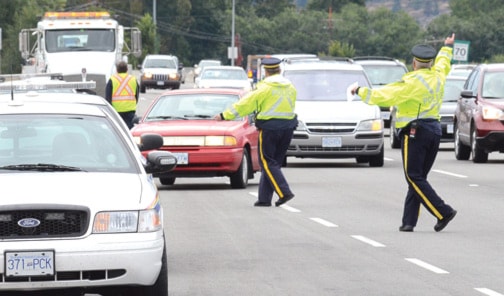Wayne Landriault shakes his head as vehicles speed by his tow truck parked on the shoulder of the highway with its flashing lights on.
“I’ve been so close to being killed so many times,” said Landriault, a tow truck driver for Penticton towing and recovery. “This hits close to the heart, that is why I am out here on my day off lending a hand to the RCMP to help bring awareness.”
RCMP Traffic Services spent Thursday morning on the stretch of Highway 97 in Trout Creek reminding drivers of the slow down, move over law that came into effect on June 1, 2009. Landriault knows all too well of the dangers posed by speeding cars passing by inches away from him as he works.
“The only reason I am standing here now is because the time I did get hit, I rolled underneath a car and it covered me. I was on the side of the road, driving a tow truck with all the lights on, wearing my vest and all of that when this fellow came down the road not paying attention and ran over me. He actually clipped me with the mirror, broke it off the car and spun me underneath the one I was holding,” said Landriault.
Luckily, Landriault walked away with only sore ribs and a twisted ankle. He asks the public to remember this next time they pass an emergency vehicle.
“People are in a hurry, they always are. Slow down and move over,” Landriault said.
Cpl. Dave Cramm of the South Okanagan Traffic Services said on Thursday they had already pulled over 50 drivers within the hour to remind them of the law that applies to not only RCMP cars but all emergency vehicles. This includes ambulances, tow trucks, fire department vehicles, vehicle inspectors, conservation officers, park rangers, special constables and commercial vehicle safety and enforcement personnel.
The rule requires drivers approaching stopped emergency vehicles displaying flashing lights to slow down, and if traffic permits, to move over into the adjacent lane in order to pass by. On roads posted at 80 kilometres per hour and above, drivers must slow to 70 km/h, and on those posted below 80 km/h, down to 40 km/h. Tickets for drivers who fail to comply carry a fine of $173 and three penalty points.
“We are out doing a visible campaign, pulling people over, providing them some literature and just informing them that this is a violation. So no tickets are being handed out,” said Cramm.
“So far today we have stopped quite a few vehicles and most of the drivers say it’s news to me and they are not aware they need to do that. These are nice, sober people who look fairly competent, but are unaware they need to do that.”
The legislation is also known as “Ernie’s Law,” in honour of Vernon tow truck driver Ernie Semkiw. In 2006, Semkiw was working with flashing lights on his truck when he was hit by a passing vehicle and killed.
The Vernon man’s manager, Keith McLachlan, vowed to Semkiw’s widow to bring the new law to life and started writing letters to the solicitor general and other government officials. Support from others, including ambulance services, strengthened his argument to change the Motor Vehicle Act. Between 2001 and 2007, 21 emergency workers were killed or injured on B.C. roads.
